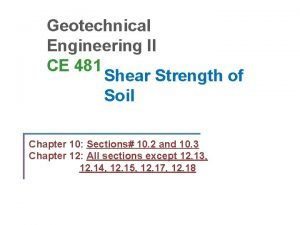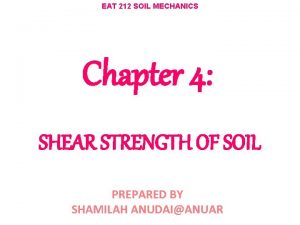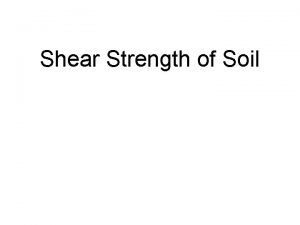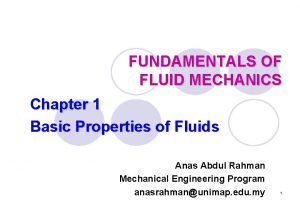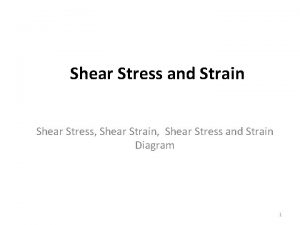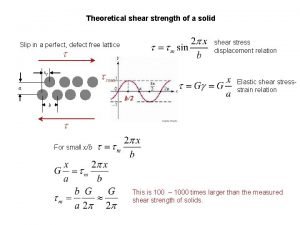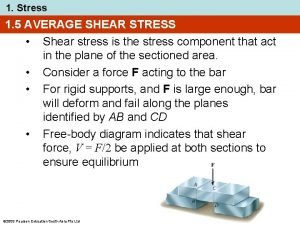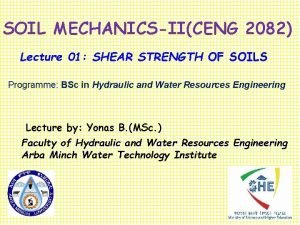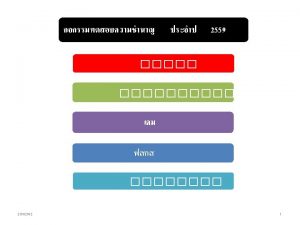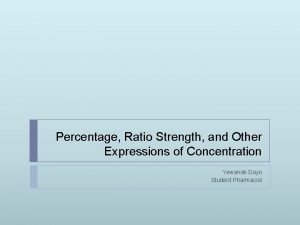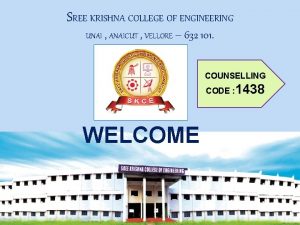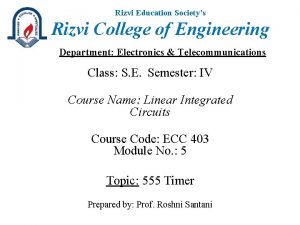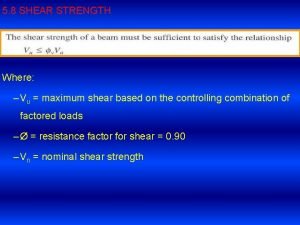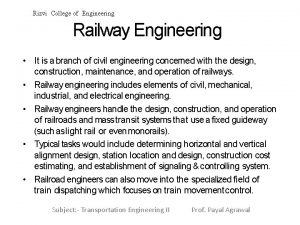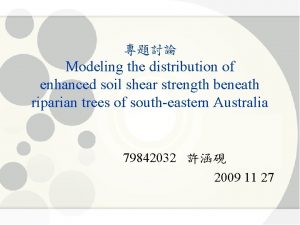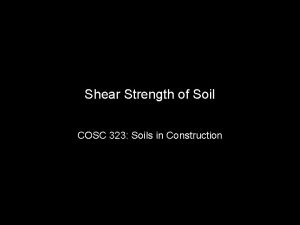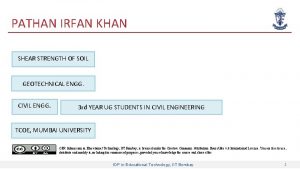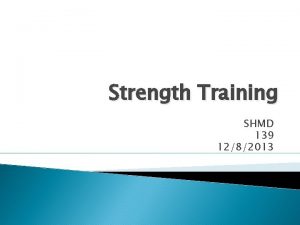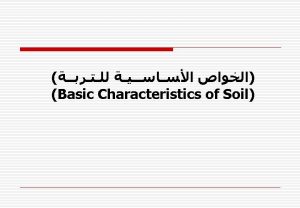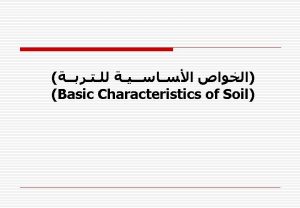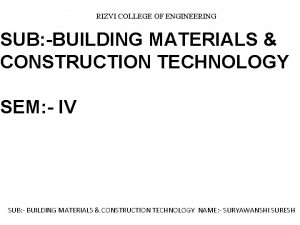Rizvi College of Engineering SHEAR STRENGTH OF SOIL




































- Slides: 36

Rizvi College of Engineering SHEAR STRENGTH OF SOIL Prof. Nikhil M. Ingale (Geotechnical Engineering-II)

Rizvi College of Engineering Content What is Shear Strength of Soil? Definitions Mohr Circle of Stress Mohr’s strength theory Mohr – Coulomb’s theory Shear strength based on drainage condition Tests for shear strength Prof. Nikhil M. Ingale (Geotechnical Engineering-II)

Rizvi College of Engineering Strength of different materials Steel Tensile strength Concrete Compressive strength Complex behavior Soil Shear strength Presence of pore water Prof. Nikhil M. Ingale (Geotechnical Engineering-II)

Rizvi College of Engineering WHAT IS SHEAR STRENGTH OF SOIL? Shear strength is a term used in soil mechanics to describe the magnitude of the shear stress that a soil can sustain. The shear resistance of soil is a result of friction and interlocking of particles, and possibly cementation or bonding at particle contacts. The shear strength of soil is the resistance to deformation by continuous shear displacement of soil particles upon the action of a shear stress. Prof. Nikhil M. Ingale (Geotechnical Engineering-II)

Rizvi College of Engineering WHAT IS SHEAR STRENGTH OF SOIL? Shear strength in soils depends primarily on between particles. interactions Shear failure occurs when the stresses between the particles are such that they slide or roll past each other. Prof. Nikhil M. Ingale (Geotechnical Engineering-II)

Rizvi College of Engineering Shear Failure in Soils Prof. Nikhil M. Ingale (Geotechnical Engineering-II)

Rizvi College of Engineering DEFINITIONS Cohesion: The attraction between the molecules of the same material is called cohesion. Dry sand is cohesion less. Addition of water in the dry and induces, a little cohesion in it. Clayey soil has maximum cohesion The cohesion of soil depends on: 1. Fineness of clay particles 2. Amount of clay 3. Water content of soil Internal friction: The frictional resistance between the individual soil particles at their contact point is known as internal friction. Angle of Internal friction : Ф It represents the frictional resistance between the soil particles, which is directly proportional to the normal stress. Prof. Nikhil M. Ingale (Geotechnical Engineering-II)

Rizvi College of Engineering MOHR CIRCLE OF STRESS At any point a strained material, there exist three mutually perpendicular planes on which only direct stresses are acting, i. e. no shearing stress acting. These are known as the principal planes. The normal stress that act on a planes are called the principal stresses. The largest of this is called the major principal stress (σ1), the smallest, the minor principal stress (σ3), and the third one is called intermediate principal stress (σ2). The corresponding planes are respectively designated as the major principal plane, minor principal plane and intermediate principal plane. Prof. Nikhil M. Ingale (Geotechnical Engineering-II)

Rizvi College of Engineering Prof. Nikhil M. Ingale (Geotechnical Engineering-II)

Rizvi College of Engineering MOHR-COULOMB’S STRENGTH THEORY Coulomb (1776), in his investigations observed that one component of the shearing Strength, called the intrinsic cohesion (apparent cohesion) is constant for a given soil and is independent of the applied stress. The other component, namely, the friction resistance, varies directly as the magnitude of the normal stress on the plane of rupture. The shear strength of a soil at a point on a particular plane was expressed by coulomb as � a linear function of the normal stress on that plane, as � S=C+ σ tan Ф � Where, � S = Shear strength of the soil � C= Cohesion � σ= Normal stress on the failure plane Ф= Angle of internal friction C and Ф are also referred to as the shear strength parameters of soil. Prof. Nikhil M. Ingale (Geotechnical Engineering-II)

Rizvi College of Engineering TYPES OF SOIL BASED ON TOTAL STRENGTH 1. Cohesion less soil (Ф- Soil) These are the soils which do not have cohesion. (C=0) These soils derive the shear strength from the intergranular friction. These soils are also called frictional soils. Examples: Sands and gravels. Equation for strength is, S= σ. Tan Ф Prof. Nikhil M. Ingale (Geotechnical Engineering-II)

Rizvi College of Engineering 2. Purely cohesive soil: (C-Soil) These are the soils which exhibit cohesion but, the angle of shearing resistance, Ф=0 These soils are called C-Soils. Example: Saturated clays Equation for shear strength is S=C 2. Cohesive frictional soil: (C-Ф soil) These are composite soil having c and Ф both. These are also called C-Ф soils. Example: Clayey sand, silty sand, sandy clay The equation for shear strength is, S= C + σ tan Ф Prof. Nikhil M. Ingale (Geotechnical Engineering-II)

Rizvi College of Engineering SHEAR TEST BASED ON DRAINAGE CONDITION Unconsolidated un-drained test: In this type of test, no drainage is permitted during the consolidation stage. The drainage is permitted in the shear stage. As no time is allowed for consolidation for dissipation of excess pore water Pressure the test can be conducted quickly in a few minutes. The test is also known as quick test (Q-test) Consolidated un-drained test: In this type of test, the specimen is allowed to consolidated in the first stage. The drainage permitted until the consolidation is complete. In the second stage, when the specimen is sheared, no drainage is permitted. The test is also known as R test. Q used for quick test, S used for slow test and R falls between Prof. Nikhil M. Ingale (Geotechnical Engineering-II) Q and S.

Rizvi College of Engineering Consolidated Drainage test: In this type of test, drainage is permitted in both the stages. The sample is allowed to consolidated in the first stage. When the consolidation is complete, is sheared at a very slow rate to ensure that fully drained condition exist and the excess pore water is zero. The test is also known as drained test or slow test (S test). Prof. Nikhil M. Ingale (Geotechnical Engineering-II)

Rizvi College of Engineering TEST FOR SHEAR STRENGTH: Direct shear test Triaxial compression test Unconfined compression test Vane shear test Prof. Nikhil M. Ingale (Geotechnical Engineering-II)

Rizvi College of Engineering DIRECT SHEAR TEST Prof. Nikhil M. Ingale (Geotechnical Engineering-II)

Rizvi College of Engineering Direct shear test Preparation of a sand specimen Leveling the top surface of specimen Pressure plate Specimen preparation completed Prof. Nikhil M. Ingale (Geotechnical Engineering-II)

Rizvi College of Engineering Direct shear test Test procedure P Steel ball Pressure plate Porous plates S Proving ring to measure shear force Step 1: Apply a vertical load to the specimen and wait for consolidation Prof. Nikhil M. Ingale (Geotechnical Engineering-II)

Rizvi College of Engineering Direct shear test Test procedure P Steel ball Pressure plate Porous plates S Proving ring to measure shear force Step 2: Lower box is subjected to a horizontal displacement at a constant rate Prof. Nikhil M. Ingale (Geotechnical Engineering-II)

Rizvi College of Engineering Direct shear test Dial gauge to measure vertical displacement Shear box Proving ring to measure shear force Loading frame to apply vertical load Dial gauge to measure horizontal displacement Prof. Nikhil M. Ingale (Geotechnical Engineering-II)

Rizvi College of Engineering PRINCIPLE OF DIRECT SHEAR TEST MN = plane of shear failure N = vertical normal load F = horizontal shear force �� 1 = Major principal stress �� 3 = Minor principal stress Prof. Nikhil M. Ingale (Geotechnical Engineering-II)

Rizvi College of Engineering MERITS OF SHEAR TEST The sample preparation is easy. The test is simple and convenient. As the thickness of the sample is small the drainage is quick and the pore pressure dissipates very rapidly. thus CD and CU tests takes relatively small period. It is ideally suited for conducting drained tests on cohesion less soils. The apparatus is relatively cheap. DEMERITS OF SHEAR TEST The stress conditions are known only at failure. The orientation of the failure plane is predetermined. This may nit be weakest plane. Control on the drainage condition is very difficult. Consequently only drained tests can be conducted on highly permeable soils. The measurement of pore water pressure is not possible. The side walls of the shear box cause lateral restraint on the specimen and do not allow it to deform laterally. Prof. Nikhil M. Ingale (Geotechnical Engineering-II)

Rizvi College of Engineering UNCONFINED COMPRESSION TEST Prof. Nikhil M. Ingale (Geotechnical Engineering-II)

Rizvi College of Engineering UNCONFINED COMPRESSION TEST Prof. Nikhil M. Ingale (Geotechnical Engineering-II)

Rizvi College of Engineering UNCONFINED COMPRESSION TEST Prof. Nikhil M. Ingale (Geotechnical Engineering-II)

Rizvi College of Engineering MERITS OF UNCONFINED COMPRESSION TEST The test is quick, simple and convenient. The test is ideally for measuring unconsolidated- undrained shear strength intact, saturated clays. The sensitivity of the soil may be easily determined by conducting the test on undisturbed sample and then on the re-moulded sample. DEMERITS OF UNCONFINED COMPRESSION TEST The test cannot be conducted on coarse grained soils such as sands and gravels. The test also cannot be conducted on fissured clays. The soils for which ∅= 0 the test results may be misleading. Prof. Nikhil M. Ingale (Geotechnical Engineering-II)

Rizvi College of Engineering TRIAXIAL COMPRESSION TEST Prof. Nikhil M. Ingale (Geotechnical Engineering-II)

Rizvi College of Engineering Triaxial Shear Test Piston (to apply deviatory stress) Failure plane O-ring Soil sample at failure Perspex cell Soil sample impervious membrane Porous stone Water Cell pressure Back pressure pedestal Pore pressure or volume change Prof. Nikhil M. Ingale (Geotechnical Engineering-II)

Rizvi College of Engineering Triaxial Shear Test Specimen preparation (undisturbed sample) Sampling tubes Prof. Nikhil M. Ingale (Geotechnical Engineering-II) Sample extruder

Rizvi College of Engineering Triaxial Shear Test Specimen preparation (undisturbed sample) Edges of the sample are carefully trimmed Setting up the sample in the tri axial cell Prof. Nikhil M. Ingale (Geotechnical Engineering-II)

Rizvi College of Engineering Triaxial Shear Test Specimen preparation (undisturbed sample) Sample is covered with a rubber membrane and sealed Cell is completely filled with water Prof. Nikhil M. Ingale (Geotechnical Engineering-II)

Rizvi College of Engineering Triaxial Shear Test Specimen preparation (undisturbed sample) Proving ring to measure the deviator load Dial gauge to measure vertical displacement Prof. Nikhil M. Ingale (Geotechnical Engineering-II)

Rizvi College of Engineering ADVANTAGES OF TRIAXIAL TEST The shear tests under all the three drainage conditions can be performed with complete control. Pore pressure and volumetric changes can be measured directly. The stress distribution on the failure plane is uniform. The specimen is free on the weakest plane. The test is suitable foe accurate research work. DISADVANTAGES OF TRIAXIAL TEST In case of drained test the test takes longer period as compared with that in a direct shear test. The apparatus is bulky, costly and elaborate. It is possible to determine the c/s area of the soil sample accurately at large strains. The consolidation of the soil sample in the test is isotropic whereas in the field the consolidation is generally anistrophic. Prof. Nikhil M. Ingale (Geotechnical Engineering-II)

Rizvi College of Engineering VANE SHEAR TEST Prof. Nikhil M. Ingale (Geotechnical Engineering-II)

Rizvi College of Engineering The shear strength S of the clay is given by T S= H D πD 2 2+ 6 if both the top and bottom of the vane partake in shearing the soil. T = Torque D = Diameter of the vane H = height of the vane if only the bottom end partakes in the shearing the above equation takes the form: T S= 2 H D πD + 2 12 Prof. Nikhil M. Ingale (Geotechnical Engineering-II)

Rizvi College of Engineering ANY QUESTIONS ? Prof. Nikhil M. Ingale (Geotechnical Engineering-II)
 Consolidated drained triaxial test example
Consolidated drained triaxial test example Shear eat
Shear eat Soil temperature ppt
Soil temperature ppt Shear strength adalah
Shear strength adalah Dynamic viscosity symbol
Dynamic viscosity symbol Factor of safety formula yield strength
Factor of safety formula yield strength Dislocation glide vs climb
Dislocation glide vs climb Shear stress
Shear stress Shear strength test
Shear strength test A325sc bolts
A325sc bolts Living soil vs dead soil
Living soil vs dead soil Four major spheres of the earth
Four major spheres of the earth Tensile strength and yield strength
Tensile strength and yield strength Percentage strength to ratio strength
Percentage strength to ratio strength Darrow solution half strength
Darrow solution half strength Ratio strength
Ratio strength Wake tech admissions
Wake tech admissions Early college high school at midland college
Early college high school at midland college Zeal dnyanganga college of engineering and research
Zeal dnyanganga college of engineering and research Thakur college of engineering and technology
Thakur college of engineering and technology Kate gleason college of engineering
Kate gleason college of engineering Ucf college of engineering and computer science
Ucf college of engineering and computer science Tagore engineering college rathinamangalam
Tagore engineering college rathinamangalam St ann's engineering college chirala faculty
St ann's engineering college chirala faculty Sree krishna college of engineering vellore
Sree krishna college of engineering vellore Gec khagaria
Gec khagaria Fnu engineering courses
Fnu engineering courses College of engineering, king abdulaziz university
College of engineering, king abdulaziz university Animals that eat both plants and animals
Animals that eat both plants and animals Uc ceas
Uc ceas Engineering staff college of india
Engineering staff college of india Swedish college of engineering and technology
Swedish college of engineering and technology Feng's classification in computer architecture
Feng's classification in computer architecture What is system in software engineering
What is system in software engineering Forward engineering in software engineering
Forward engineering in software engineering Dicapine
Dicapine Elegant systems
Elegant systems
